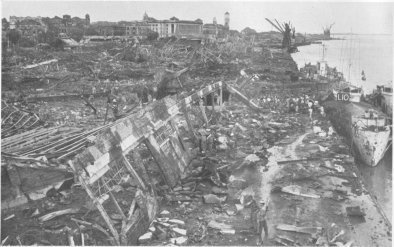![]() The Pacific War Online Encyclopedia
The Pacific War Online Encyclopedia
|
| Previous: Rangers | Table of Contents | Next: Rarotonga |

Royal Air Force. Via ibiblio.org. Fair use may apply.
Capital of Burma,
Rangoon (96.17E
16.77N) was the port through
which all Lend-Lease
supplies were shipped to China.
It was also a major oil
port, with a refinery and storage tanks for oil produced in the Irrawady Valley.
The population was about half a million, of whom over half were ethnic Indians. The Irrawady Delta was ideal for rice
production, and Burma was the third largest exporter of rice in the
world prior
to the Pacific War.
Fall of Rangoon. When war broke out, Rangood was protected by a
battalion each of British
regulars and Burmese native troops. The city came under air
attack
starting on 23 December 1941.
The near-destruction of 17 Indian Division after it was trapped on the east side of the Sittang River meant that Rangoon could not be held against the Japanese advance. It was evacuated by the British on 7 March 1942, by which time much of the population had fled and looting and arson had become widespread. The police force, mostly Indians and resented by the Burmese, had heard rumors that the Japanese in the Tenasserim had turned police over to local mobs, and as the Japanese approached they panicked and fled. The city was occupied by the Japanese 33rd Division the next day, 8 March 1942, who found the oil refineries at Syriam ablaze and the port thoroughly demolished.
Following its conquest, Japan imported up to 560,000 tons of rice per year from Rangoon before the submarine blockade cut off shipments.
Liberation. Following the fall of Mandalay on 20 March 1945, Slim found himself in a race to reach Rangoon and end the Burma campaign before the monsoon arrived. This required his forces to race past any strong pockets of resistance and rely on resupply by air. This was a risky strategy, but it worked. Although the monsoon hit when the British troops were still 50 miles north of Rangoon, at Pegu, a British amphibious force landed on 2 May (DRACULA) to find the Japanese had evacuated the city.
The defending 105 Independent Mixed Brigade, a scratch formation under Matsui Hideji,had
been ordered to defend Pegu and had in fact put up considerable
resistance, demolishing all three bridges in the town. However, on 1
May the brigade was ordered by Kimura to return to Rangoon and defend it to the death. Instead, he bumped into 17 Indian Division and was forced to retreat into the Pegu Yomas hills. Before doing so, he ordered all his British prisoners of war
released and the docks demolished, suggesting he had never intended to
return to the city. Kimura in turn had evacuated Rangoon on 23 April
1945, a decision that many Japanese officers considered disgraceful.
However, Ba Maw, leader of the collaborationist
Burmese government, had strongly hinted that any "scorched earth"
operations in southern Burma would have the gravest political
consequences.
DRACULA was overkill. The invasion force was escorted by two cruisers, four destroyers, and the four escort carriers of 21 Aircraft Carrier Squadron with additional air cover from 224 Group and eight Liberator squadrons and four Mitchell squadrons from the Americans. Distant cover was provided by 3 Battle Squadron, consisting of battleships Queen Elizabeth and Richelieu, two escort carriers, four cruisers, and six destroyers. The landing force itself was 26 Indian Division (Chambers) which had extensive experience working with the Royal Navy during the Arakan campaign.
On 30 April 1945, Allied aircraft flying over Rangoon
reported that the jail had the words "JAPS GONE. EXTRACT DIGIT" painted
on its roof. The second phrase was rude RAF slang whose approximate
meaning was "expedite." The decision was made to carry out DRACULA anyway, and a detachment of Force 136 and a battalion of 50 Indian Parachute Brigade
parachuted onto the approaches to Rangoon the next day. However, as the
invasion force began coming ashore on 2 May, an enterprising British airman, Wing Commander Saunders, crash-landed his Mosquito on the cratered Rangoon runway
and made his way to the Rangoon jail, where he found over 1000 prisoners of war who
told him the Japanese had left on 29 April. Saunders nonchalantly
proceeded to the docks, commandeered a sampan, and met the invasion
force on 3 May. 26 Indian Division linked up with Slim's 14 Army on 6 May 1945.
The final advance on Rangoon was preceded by Operation
CHARACTER, on 18 April 1945, in which a substantial commando force was inserted behind
the Japanese lines to gather intelligence
and disrupt the Japanese lines of communication. The operation was
highly successful, killing an
estimated 10,000 Japanese troops at the cost of sixty British commandos.
Climate Information:
Elevation 18'
Temperatures: Jan 89/65, Apr 97/76, Jul 85/76, Oct 88/76, record 106/68
Rainfall: Jan 0.3/0.1, Apr 2/2.0, Jul 26/22.9, Oct 10/7.1 == 103.0" per annum
References
Sandhu and Mani (1993; accessed 2011-8-13)
The Pacific War Online Encyclopedia © 2007, 2010-2011 by Kent G. Budge. Index